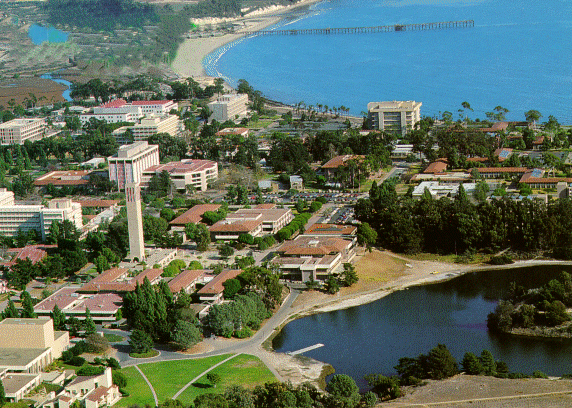
Samuel P. Burke
Development Engineer
Address
|
|
|
|
|
5225 |
|
|
(805)893-7835 (office) |
|
|
(805)893-5995 (fax) the machine is in our Engineering office. |
|
|
|

Here is a view of the UCSB Campus, the physics building is located along a vertical line drawn from the right hand side of the tower tothe second building crossed. We have a good running path (3.03 sm loop in 30 min for me!) around the lagoon. and over the beach and back to the facilty club shown on the lower left of the photo. The club has a nice pool to cool off in after a warm run!
=====================================================================================
CMS LP Filter: LPFilSch1.pdf LPFilResp1.pdf LPFilBrd.pdf
Inductor.pdf LPFilResp2.pdf
LPFilCable.jpg LPFilScale.jpg RodEnd.jpg
LPFilconn2.jpg Pwr Conn.jpg Slides.ppt
LPFilTestSetup.jpg LPFilTest3.jpg Inductor1.pdf LPFilterPwr.jpg
LPFilterBoard1.jpg
LPFilterBoard2.jpg http://hep.ucsb.edu/people/sburke/cms/CMSRodLPFilterIndex.html
*
CMS Rod Connector Repair: CCUM_Cable.pdf CCUConnFix1.jpg CCUStrainRel.pdf Repair1.jpg Repair2.jpg Repair3.jpg Splice2.pdf Splice.pdf
CMS Rod Current
MPX: RodCurrent1.pdf
xx http://hep.ucsb.edu/people/sburke/cmshvmpxindex.html
Cold Dark Matter Search
As of the spring of 1999 I have become associated with searching for dark-matter under the direction of Harry Nelson. The experiment we are working on has the goal of measuring the presence of a passing Week Interactive Massive Particles ( WIMP ) using the Cryogenic Dark Matter Search ( CDMS ) system currently set up in a cave under the Stanford campus. My initial involvement with the project will be on a series of special logic boards which are being developed to collect a number triggers generatred by sensors in the system to generate a global trigger which will start the data collection process.
HEP ASIC Design Effort
http://hep.ucsb.edu/people/sburke/asic/
HEP Electronics Lab Page :
http://hep.ucsb.edu/people/sburke/heplab1.html
HEP Neutron Flux Experiment Page :

BaBar Vertex Detector Work
I am now working to develop automated test instrumentation for the Silicon Vertex Detector for the BaBar experiment SLAC B-Factory . Recently we have developed a connection scheme used to protect the special flat cable tail and the Berg surface mount connector located on the SVD High Density Interconnect (HDI), the connection scheme consists of a pair of 4.6 cm flex jumpers which connect to the HDI Berg conncetors and to a special double sided card edge pc board which in tern connects to the Babar matching card by way of an adaptor cable assembly.
Our group has been looking at the response of the BaBar Silicon Particle detectors to bursts of monochromatic light using LED sources . The test system we are using for this work is the LabVIEW driven LEDSCAN p rogram which Jeff Richman and I developed over the past year. Most of our work has been focused on study of the silicon response to short bursts of 820 nm wavelength light focused on the detector surface forming a 500 nm diameter spot.
We have recently completed a burn-in system for our growing number of wire-bonded detectors. The system is refered to as the Detector Fanout Assembly Dorm. The unit accomodates up to 6 seperate DFA's in their Ring-Frame Assemblies. Here is a real time link to our dorm .
Here is a link to the SVT testand software page. Here are photos of some of the detectors and the instrumentation. I have also been spending some time working with Claudio on the BaBar Test Benc h, Doug Roberts has been managing this web page.
The physicists in the UCSB Babar group whom I work with are; Claudio Campagnari , Jeff Richman , Doug Roberts , and Mike Witherell .

This was taken on Mother's day with the girls at the Red Lyon. Sandy will be getting married in May of 98.
Since the summer of 97 I have been taking flight training in a Piper Archer II with the Santa Barbara Flying Club , just passed by FAA practical on Saturday 19 May!!, Now I can take passangers!
